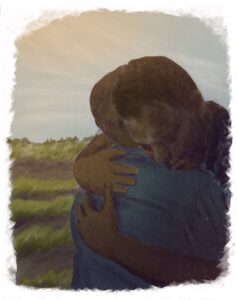
The blooming of dogwoods triggers an intense longing for my grandparents, George and Mary Ellen Naff.
As a child, I spent many hours climbing the white dogwood in their front yard, often in church dresses and patent-leather shoes. Granddaddy would hold my hand as I climbed higher and higher and then he’d turn quick enough to catch me when I jumped down.
In my memory he is there by the tree dressed up, too. He wears a grey suit and tie or a button up shirt and slacks, probably just home from visiting parishioners in the hospital or from one of the rural churches he served after retiring from the college.



My grandparents lived directly across the street from us until I was about 8 years old. Their house and yard were like a revolving door for our family.
I’d run up the driveway and into their house unannounced and if Granddaddy was there in his recliner, he’d exclaim, “Oh, goody, goody!” If Grandmama greeted me first she’d hug me breathless.
I saw them multiple times a week, but I swear my grandparents greeted me with the same wonder-full enthusiasm every time.
After salutations, I’d fly deeper into the house in search of food or entertainment. They had all the goodies: a cookie jar and fresh-made lemonade, a stack of Reader’s Digests and a rocking chair for small bottoms.
Andrew and I loved Granddaddy’s study and his desk, which was full of pens, scraps of paper, old driver’s licenses, business cards, loose change, paper clips and rubber bands. A real smorgasbord.
I loved to visit my Grandmother’s jewelry box. It held treasures, like my great-grandmother Clara’s gold locket with pictures of a very young Clara and her slightly older husband, Walter Steele, inside.
Grandmama usually joined me for these jewelry box sessions and the treasures became stories. We had a routine of repeating the origin story for most pieces, like the silver and turquoise cross pendant, which was a gift from my Aunt Nancy Jo, and the history of the broach that belonged to my Great-Aunt Evelyn.
I enjoyed working through all the charms on Grandmama’s heavy silver charm bracelet, noting the birthdates for every grandchild (eight boys, one girl!) and the charms gifted by church women to my grandmother when she and Granddaddy moved to their next appointment in the Holston Conference.
The grand finale of these jewelry sessions involved me admiring myself in the mirror, decked out in costume jewelry, a pair of Grandmama’s high-heels and bright pink Revlon lipstick.
Springtime brought Grandmama outside to work in her flowerbed and inspired Granddaddy to put on shorts, revealing his skinny, white legs while he mowed the yard. My brother and I could watch them work from just across the street and feel safe and anchored to our home, the sky, the dogwoods and this family playground.
On my eighth birthday, we all moved — my family just a few blocks away and my grandparents to the Asbury Acres retirement community in Maryville. The disbanding of our family compound didn’t affect our proximity to love, but it was the end of one of the golden variations of my life.
Each spring, my eyes begin to burn again — with allergies, of course — but also with memories of that time when my grandparents were loving me into being. It’s a gift to resurrect those memories now, this spring, in the midst of a global pandemic.
The dogwoods are blooming anyway.








